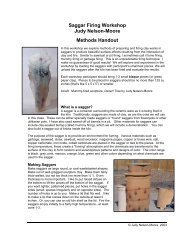Create successful ePaper yourself
Turn your PDF publications into a flip-book with our unique Google optimized e-Paper software.
<strong>Fume</strong> <strong>Firing</strong> <strong>Methods</strong> <strong>Handout</strong> Page 6 of 8<br />
Sumi Van Dassow Pit <strong>Firing</strong><br />
(notes from Ceramic Arts Daily posting: http://ceramicartsdaily.org/firing-techniques/pit-firing-video-a-guide-togathering-fuels-for-the-best-results-in-a-pit-firing/)<br />
Pit: 3 feet x 6 feet, looks about 2.5-3 feet deep. Edge of pit is rimmed with bricks. On bottom of pit is<br />
rectangular arrangement of galvanized pipes with holes drilled in the pipe every few inches. End of pipe<br />
extends out of pit to hook to an electric air blower. This pushes draft into the bottom of the pit.<br />
Materials: Aspen or Cottonwood branches, very dry. Wood shavings, fresh from feed store AND dried used<br />
stable sweepings with urine and manure. Dried used coffee grounds. Dried salt-soaked corn husks. Wood<br />
scraps from cabinet shop. Salt, copper carbonate.<br />
Stack: Put layers around pipes and on top. 1) clean wood shavings, 2) well dried stable sweepings, 3) used<br />
coffee grounds well dried, 4) big pots, 5: smaller pots nestled around big pots (can wrap pots in salt soaked<br />
materials), 6) salt-soaked stuff, 7) crumples newspapers, 8) crisscrossed sticks from cabinet shop, smaller<br />
ones first, 9) dried branch pieces from aspen or cottonwood. Start fire. Then throw on top copper carbonate<br />
mixed with wood shavings. Cover. Turn on blower low.<br />
<strong>Firing</strong>. Lasts about 5 hours. Cover tightly, let completely cool. Temperature about 1200-1400 or cone 018.<br />
Recipes<br />
Sumi Von Dassow Terra Sig<br />
2100 g water<br />
1000 g Kentucky OM4 Ball Clay<br />
25 g Darvan 7 or 811<br />
Mix together in clear jar. Let set at least 3 hours. Siphon off all but the bottom sludge. Burnish with fingers and<br />
auto polishing mitt.<br />
Terra Sigillata (George Tompkins, Yuma Arizona)<br />
15g Calgon (original formula)<br />
500g Clay<br />
1 gal Water<br />
Let stand overnight. Pour or siphon off top ¾. Let thicken or boil off water. Should be thickness of milk or ½ and<br />
½.<br />
George Tompkins’ Bone (greenware) slip. Can also apply thin to bisque.<br />
50 Edgar Plastic Kaolin (EPK)<br />
25 Nepheline Syenite (Nephsy)<br />
25 Frit #25<br />
George Tompkins’ Bisque slip (this makes a velvety matt surface)<br />
25 EPK<br />
50 Nephsy<br />
25 Frit #25<br />
For dark colors, add up to 20% copper carbonate. Spray or brush on Bisque<br />
Edgeworth Barnes’ Swamp Juice<br />
Equal Parts copper sulfate<br />
fine sea salt<br />
cottonseed meal<br />
baking soda<br />
1/2 part each copper carbonate<br />
titanium dioxide<br />
For larger pots he mixes these materials with water to create an evil-looking bubbling liquid and brushes this juice<br />
directly onto the saggar to avoid having all the chemicals concentrated only near the bottom of the pot.<br />
Warning…when adding water, this REALLY bubbles up and fumes are very toxic.<br />
© Judy Nelson-Moore, 2010



